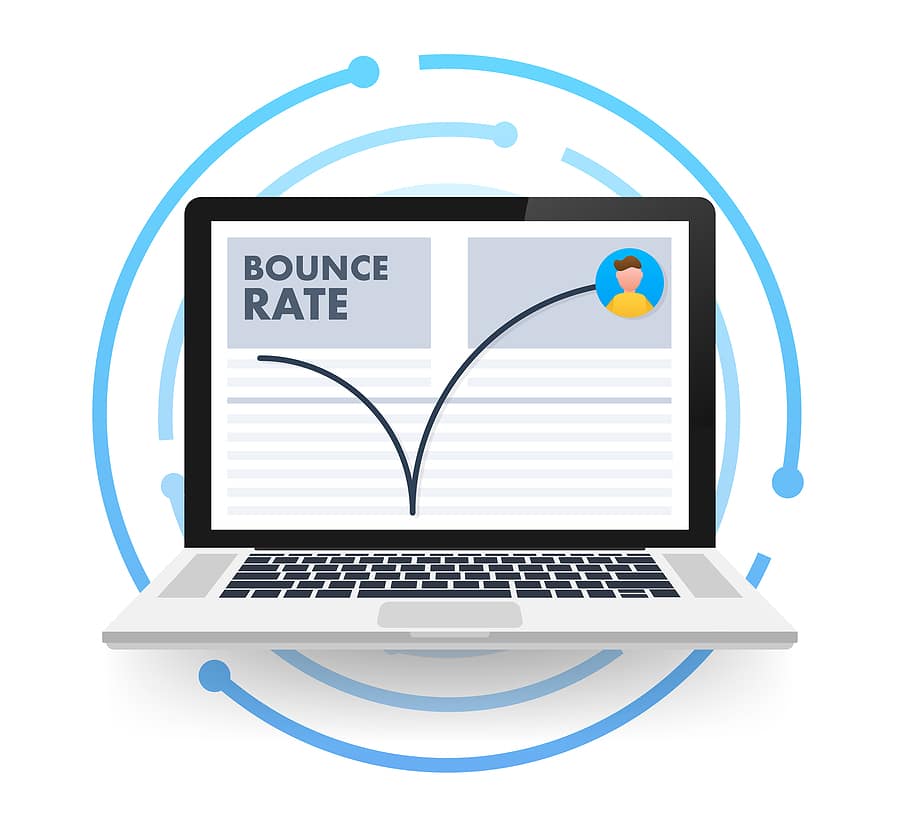How to Reduce Bounce Rate and Improve User Engagement on Your Website

In the vast and competitive landscape of the internet, capturing and maintaining the attention of your website visitors is crucial for any website development team as part of your overall digital marketing strategy. This is why it is important to under how to reduce bounce rates!
Bounce rate, a metric that indicates the percentage of visitors who leave a website without interacting with any elements on the page, is a significant measure of user engagement. A high bounce rate can be detrimental to your online presence, indicating that visitors aren’t finding what they’re looking for or that your website fails to engage them effectively. This is why it is important to understand how to reduce bounce rates on your site.
Fortunately, there are numerous strategies you can employ to reduce bounce rates and enhance user engagement. In this comprehensive guide, we’ll explore these strategies in detail, providing you with actionable tips to keep your visitors interested and invested in your website.
Understanding Bounce Rate: A Quick Overview
Before diving into the methods for how to reduce bounce rate, it’s essential to understand what bounce rate is and why it matters. The bounce rate is calculated by dividing the number of single-page sessions by the total number of sessions on your website. A single-page session occurs when a visitor leaves your site after viewing only one page. High bounce rates typically suggest that visitors are not finding what they expected, leading them to exit your website promptly.
1. Create a Clear and Compelling Website Design
a. Intuitive Navigation:
A well-organized, easy-to-navigate website encourages visitors to explore multiple pages. Implement clear menus, logical page hierarchy, and intuitive CTAs (Call to Actions) to guide users seamlessly through your site.
b. Mobile-Friendly Design:
In an era dominated by smartphones, ensuring your website is responsive and optimized for mobile devices is non-negotiable. A mobile-friendly design enhances the user experience, reducing bounce rates significantly.
2. Optimize Page Loading Speed
a. Minimize Image and Video Sizes:
Large media files can slow down your website. Compress images and videos without compromising quality to ensure quick loading times. Work with your technical development team to use tools like Photoshop or online services like TinyPNG to optimize your visuals.
b. Leverage Browser Caching:
Browser caching stores frequently accessed resources on visitors’ devices, reducing loading times for subsequent visits. Implement caching mechanisms to enhance the user experience, especially for returning visitors.
3. Produce High-Quality, Relevant Content

a. Know Your Audience:
Understanding your target audience enables you to create content tailored to their interests and needs. Conduct market research, analyze customer feedback, and employ tools like Google Analytics to gain valuable insights into your audience’s preferences.
b. Quality over Quantity:
Focus on creating high-quality, informative, and engaging content. A well-researched, valuable piece attracts and retains visitors, reducing bounce rates. Avoid keyword stuffing and prioritize readability and relevance.
4. Improve Website Credibility and Trust
a. Professional Design:
Invest in a professional website design that reflects your brand identity. A visually appealing and credible website instills trust in your visitors, reducing the likelihood of immediate exits.
b. Display Trust Signals:
Incorporate trust signals such as SSL certificates, privacy policies, and secure payment gateways. Clearly display customer testimonials, industry certifications, and awards to enhance your website’s credibility.
5. Enhance User Engagement
a. Interactive Elements:
Incorporate interactive elements like quizzes, polls, and surveys to engage visitors actively. Interactive content encourages participation, prolonging the time visitors spend on your site.
b. Internal Linking:
Strategically place internal links within your content to guide users to related articles or products. Well-placed internal links not only enhance user experience but also reduce bounce rates by encouraging exploration.
6. Optimize Calls to Action (CTAs)
a. Clear and Compelling CTAs:
Craft persuasive CTAs that clearly convey the desired action. Use action-oriented language and place CTAs strategically throughout your website to guide visitors further into the conversion funnel.
b. A/B Testing:
Conduct A/B tests to evaluate the effectiveness of different CTAs. Experiment with variations in text, color, placement, and size to identify what resonates best with your audience.
7. Improve Page Relevance and Targeting
a. Keyword Optimization:
Optimize your content for relevant keywords and phrases. Conduct keyword research to identify high-performing keywords in your niche. Use these keywords naturally within your content to attract visitors genuinely interested in your offerings.
b. Landing Page Relevance:
Ensure that visitors arriving on your site through search engine results or ads find content that aligns with their search intent. Irrelevant landing pages lead to quick exits. Tailor landing pages to match the specific keywords or ads that direct visitors to your site.
8. Utilize Exit-Intent Popups
a. Engage Leaving Visitors:
Exit-intent popups are triggered when a visitor shows intent to leave your site. Use these popups strategically to offer discounts, free resources, or newsletter subscriptions. By providing value, you might convince exiting visitors to stay engaged.
9. Regularly Analyze and Iterate
a. Utilize Analytics Tools:
When it comes to understanding how to reduce bounce rates, leverage web analytics tools like Google Analytics to track user behavior, identify high-bounce pages, and understand the customer journey. Analytical insights enable data-driven decisions to optimize your website effectively.
b. Continuous Improvement:
Use the data gathered from analytics tools to iterate and improve your website continually. Test different strategies, monitor their impact, and refine your approach based on the results. A proactive attitude toward improvement can significantly reduce bounce rates over time.
How to Reduce Bounce Rates- Conclusion
In conclusion, learning how to reduce bounce rates is a multifaceted endeavor that requires a holistic approach to user experience, content quality, and website functionality. By focusing on intuitive design, fast loading times, engaging content, and strategic optimization, you can create a website that captivates visitors and encourages prolonged interactions.
Remember, the key lies in understanding your audience, providing value, and consistently iterating based on data-driven insights. By implementing the strategies outlined in this blog, you can significantly reduce bounce rates, improve user engagement, and create a loyal and satisfied visitor base for your website. You may also feel free to contact us to learn more about how we can help!





